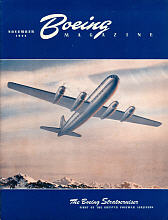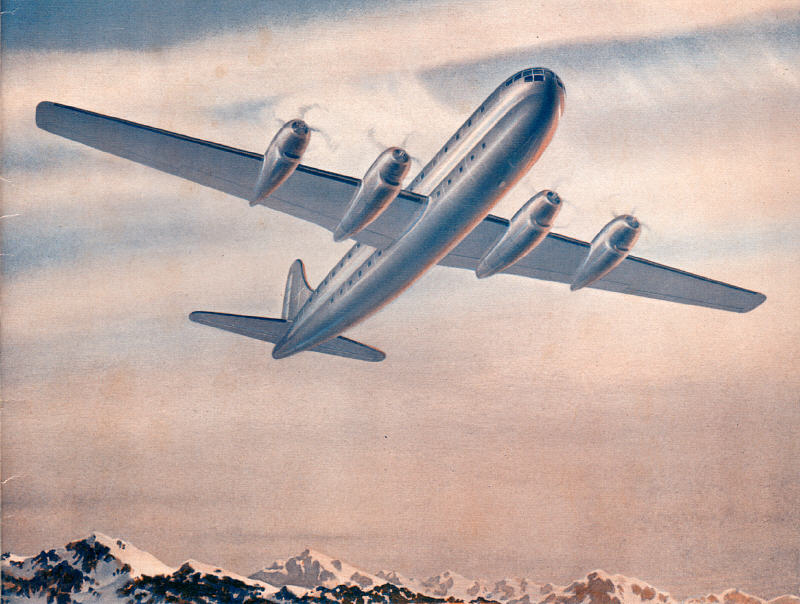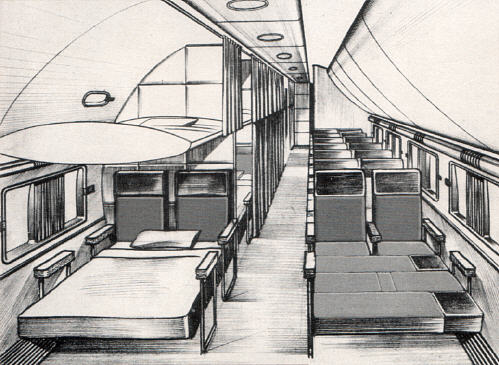





From «Boeing Magazine», November 1944








First of the greater postwar Airliners


The wraps are off the first of the post-war super airliners. It's the Boeing 377, the most advanced commercial transport ever developed. It's tomorrow's airplane, but it flies today.
THE average citizen has long pictured tomorrow's airliner as a huge, super-sleek creation with radical lines and fabulous performance. This month at its Renton plant, Boeing unveiled a ship that is the dosest real-life approach yet made to the average citizen's picture. The ship, known as the Boeing 377 Stratocruiser, is a double-deck transport developed from the basic engineering of the Boeing B-29 Superfortress.
With the prototype of the 377 now built, and undergoing tests, the cloak of secrecy has been dropped that shrouded its development and construction for two-and-a-half years. Outside of the people who worked on it and the airlines representatives who contemplated it with keen appreciation, it was not known to anyone at all.
While the 377 is being planned for the post-war commercial airline market, all present models will be for military service. The 377 is the largest four-engine land transport yet built, and as equipped for postwar airline operation is the fastest among the various competitive designs. Planned especially for transcontinental and transoceanic routes, it comfortably accommodates up to 100 passengers. It can fly non-stop from New York to London.
With payload, the 377's range is 3500 miles. It is a silver streak with muscles, designed for that long-dreamed-of combination of tremendous speed, tremendous range and tremendous payload.
For airline use, it will be powered with the biggest aircraft engines ever put in an airplane. These four power plants will develop 3500 horsepower each at take off. The big transport's top speed is 400 miles per hour, probably faster than any other large plane ever built. Its cruising speed is 340 m.p.h. At 20,000 feet it can operate with only three engines.
The pressure-cabined ship has a double lobed, or upside-down figure 8, fuselage. The lower lobe is similar in size to a B-29 body. The upper deck is a large size fuselage riding pickaback. The most beautiful feature of the double deck arrangement, so far as the airline people are concerned, is its flexibility of payload.
The twin decks can be split up into three separate cabins. One is the main upper cabin and the other two are divisions of the second deck. This leads to great flexibility in arrangement for various combinations of passengers and cargo. There are, at present, three principal prospective arrangements.
One model is a streamliner day-coach of the sky, a low-fare, high-speed transport. This airplane can carry passengers at a direct operating cost (just running the airplane) of one cent a mile, considerably lower than any competitive design. With comfortable, roomy seats installed in both decks, it would carry 100 passengers and still allow ample baggage space. This model is primarily for daytime use on heavily traveled routes. Low fares would enable it to compete for the large field of traffic now carried by railroads and buses.

It would be an easily made adjustment to use the lower front cabin for baggage and cargo, increasing the baggage space to 750 cubic feet. This much extra cargo would replace fourteen passengers, giving the plane a seating capacity of eighty-six.
The second version of the 377 is a luxury sleeper plane. This model would have on the upper deck seventy-two seats or thirty-six comfortable berths. In the lower rear cabin there would be an observation and dining salon seating fourteen people, and in the lower front cabin, cargo space and crew's quarters. This arrangement would be the most desirable for long ocean flights.
A third version is an all-cargo model. With both decks used for cargo the 377 would have 3000 cubic feet of cargo space and would carry a 35,000-pound load. The 377 would transport this cargo at a direct operating cost approximating five cents per ton-mile. A drive-up ramp at the rear of the plane allows easy loading. Internally, the cargo is handled with special equipment.
The Stratocruiser outstrips any other ship in payload. As economical a plane as the 377 will enable airlines to carry passengers faster at a lower cost than at present.
Ship maintenance has been made as simple as possible to keep operating costs down. One such simplified maintenance procedure is a fuselage construction that exposes all equipment and mechanical operating devices so that they easily can be repaired on the ground and even can be reached while the ship is in flight. All four power plants are quickly interchangeable and designed for ease of maintenance.
Loading the cargo hold is simple, too. No special lifting apparatus is necessary. Such arrangements make for quick ground service and keep the ship in the air on paying flights instead of on the field.
The Stratocruiser's gross weight is sixty-five tons. It has a wing span of 141 feet, 234 inches, which is the same as the B-29 wing. The body is 110 feet, 4 inches long, 12 feet longer than the Superfortress.
Luxury will mark the 377's fittings for passengers. The upper cabin is sixty feet long and in cross-section is more than fifteen feet wide. In this spacious area, which is several times the size of the interior of the B-29, will be the seating and sleeping arrangements for travelers. Dressing rooms and a luxurious ladies' lounge are planned for the main cabin. A galley serves meals either to passengers in their seats or in the lower deck dining room.
To the traveler who climbs aboard the 377, the ship looks like a gigantic silvery streamlined coach. Aerodynamically, the 377 is as well-shaped as the B-29 and inherits its aerodynamic performance. The fuselage, being larger, has more drag than the B-29 but this extra drag is offset by the absence of gun turrets.
Soaring on flights over the airlanes of the future, the 377 will carry passengers in comfort at high altitudes above weather disturbances. It will travel at heights up to 25,000 feet with cabin atmosphere equivalent to 8000. This pressure cabin feature was originally developed by Boeing in the Stratoliner and developed further in the Superfortress.
An extra comfort is the controlled rate of "descent" of the cabin pressure to allow passengers to adjust ears that have been thrown off by a lower pressure outside the ear than inside. The pressure in the cabin is increased at a slow measured rate for passenger comfort, regardless of how fast the ship descends.
The wings, tail and landing gear of the 377 are the same as they are on the B-29, along with many other features of the world's mightiest bomber. Further, the refinements and modification obtained from B-29 flight experience will be directly inherited by the 377.
For luxury, the 377 is the closest aerial approach to the Queen Mary.

Designing an airliner consists of much more than aerodynamics and powerplants. Designers often have to be interior decorators and furniture movers.
WHEN aircraft designers go to work on the passenger and cargo arrangements for a new luxury airliner, they are more meticulous than an inter ior decorator with a million-dollar man sion on his hands. At least that's the way the Boeing designers operate. The new Stratocruiser is the world's best example.
The 377 was designed from the first to be the most flexible, most versatile air transport ever built. It can carry passengers and cargo in three major combinations, as a high-speed transport, a luxury sleeper or an all-cargo plane. But that is not all the story, by a long hop.
The preliminary design engineers demonstrated the versatility of the plane in the number of seating, sleeping, lounging and cargo arrangements possible. They worked out dozens of interiors, turned them over to the artists of the engineering handbook unit for finished drawings.
The views on this page are typical, They represent what is known as Arrangement B, designed to carry sixty day passengers and sleep thirty. Another arrangement carries eighty-five by day, fifty at night, and so on, depending upon what the particular airline wants for its own purposes.
The top drawing is a plan view, looking down on the upper deck. Directly behind the control cabin, in this sample layout, is a complete galley. From the galley a long corridor bisects the plane from stem to stern, lined mostly with comfortable, Pullman-like seats on either side. For sleeper use, the seats can be converted into berths.
The drawing shows two pairs of seats, in the center of the plane, made up into berths. The semi-circle directly across the aisle is a circular staircase leading down to the salon on the lower deck. In the extreme rear of the plane is the ladies' lounge.
The cross-sections show the unusual inverted 8 shape of the fuselage at three different spots along the length of it. The first shows the crew's hatch with steps leading from the upper deck to crew quarters on the lower deck. In the second view, the circular staircase leads from the top-deck aisle, beside two madeup berths, down to the cocktail lounge. The third of the cross-section drawings shows seats upstairs, cargo space below and toward the tail of the plane. To the right is a plan view looking down into the cocktail lounge or dining salon, with the seats in horseshoe-like arrangement.
The profile view at bottom. shows comparison in size of upper and lower decks. What shows here as blank space in the nose contains the control cabin (upper deck) and the nosewheel well (below deck). The dotted circles are, of course, the wheels.





